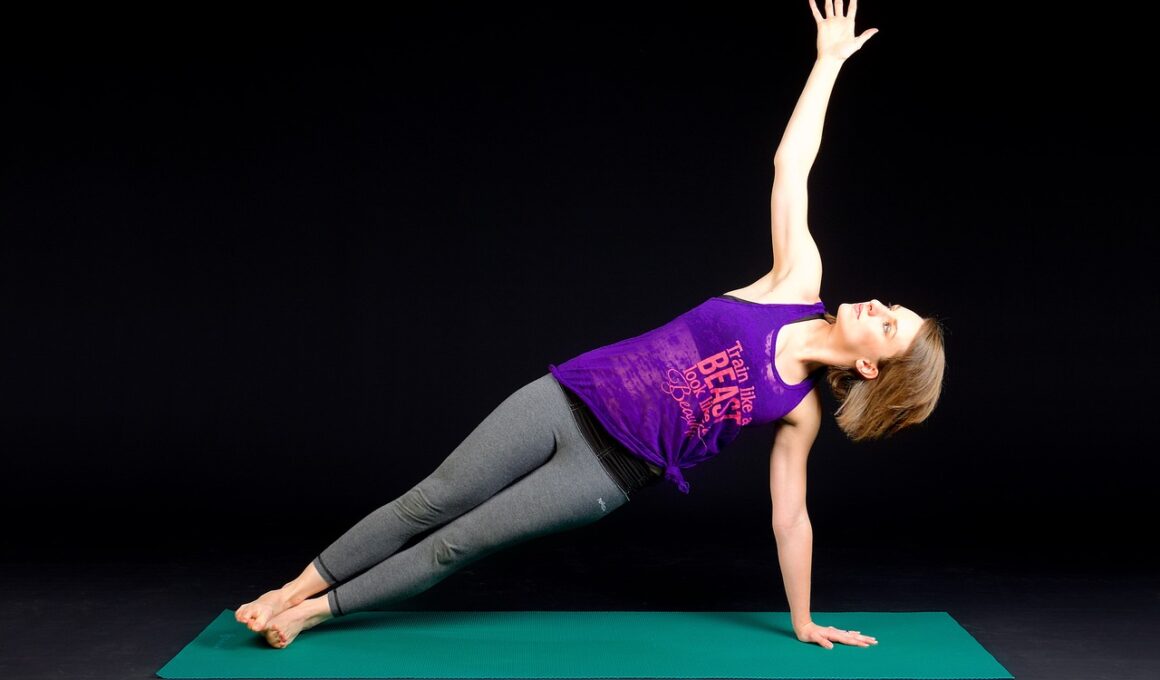Advanced Core Workouts Using Resistance Bands
Resistance bands are exceptional tools for enhancing your core workouts, especially for advanced users looking to challenge their strength and stability. Incorporating these bands into your routine not only increases resistance but also improves your range of motion. This versatility allows you to target multiple muscle groups while focusing on core engagement. The unpredictable nature of resistance bands forces your muscles to adapt, thereby strengthening your stabilizers effectively. Your workout can include various positions and movements, such as standing, kneeling, or lying down, all of which can be amplified with bands. To enhance your workouts, try exercises like standing oblique twists or banded planks. Always ensure proper form to prevent injury and maximize efficiency. Moreover, using bands can help in injury rehabilitation as they provide variable resistance and reduced impact compared to traditional weights. This means you can work your core without undue strain. Set clear fitness goals and progressively increase the challenge of your workouts. Mixing in intensity and duration with resistance bands can lead to impressive results in overall core strength.
Once you’ve mastered the basics, it’s time to explore complex maneuvers designed for advanced users. Advanced core workouts with resistance bands can include exercises like the “banded dead bug” or the “banded Russian twist.” These movements require a combination of strength, coordination, and endurance, perfect for advanced levels. The dead bug targets your rectus abdominis while engaging your limbs, enhancing core stability and coordination. The Russian twist, on the other hand, focuses on rotational movement, essential for improved core strength and performance in various sports. When performing these exercises, ensure that your bands are properly anchored, as this stability is crucial. It’s vital to maintain controlled movements throughout. Consider incorporating different band tensions to keep your muscles guessing and to achieve progressive overload. A set of bands with varying thickness can enhance your workout versatility. Keep track of your reps and sets for each exercise to monitor improvements over time. The key here is consistency and gradually increasing your **resistance** and intensity to continue progressing. Remember to take rest days to allow muscles to recover.
Core Stability Exercises
Maintaining core stability is fundamental for advanced workouts. To ensure you strengthen the core effectively, exercises such as “banded bird dogs” and “banded plank reaches” can be beneficial. The bird dog engages your entire core while promoting balance and stability by combining limb movement with resistance. This helps strengthen the lower back as well, which is crucial for overall body mechanics. On the flip side, the banded plank reach challenges your core stability by requiring you to extend one limb while maintaining a stable torso. You can vary the tension of the band to increase or decrease the difficulty as necessary. Remember to engage your core throughout each movement for maximum effectiveness. Performing these exercises consistently can help establish a solid foundation for other high-intensity activities. Additionally, you may also consider adding a “banded side plank” to the routine to correctly engage the oblique muscles. This exercise not only stabilizes your core but enhances your overall muscle endurance as well. Rotating these exercises into your weekly schedule encourages balanced strength development and helps avoid plateauing.
Pair your core stability workouts with movements that focus on dynamic strength for a comprehensive routine. For example, consider incorporating “banded overhead presses” and “banded single-leg deadlifts” into your regimes. These workouts engage not just the core but also the upper and lower body, improving functional strength. The overhead press engages the upper body while keeping your core engaged, reinforcing stability throughout the exercise. The single-leg deadlift targets the hamstrings and glutes while requiring core stabilization, making it an effective compound movement. When using resistance bands, be mindful of the range of motion to avoid injury. Integrating multiple joint actions in these movements not only enhances core strength but also boosts cardiovascular fitness and coordination. Make sure to adjust your body alignment and core positioning whenever you shift from one exercise to another. The result is a more comprehensive workout that addresses various body aspects. Remember to track your progress and possible adjustments regularly. These advanced workouts should leave you feeling challenged without risking overexertion. Incorporate adequate warm-ups and cooldowns while acknowledging your body’s feedback throughout.
Incorporating Cardio with Resistance Bands
Adding cardio to your resistance band core workouts can amplify calorie burn and endurance. High-Intensity Interval Training (HIIT) with bands can take your core workouts to the next level. By switching between powerful bursts of banded movements—like marches or lateral band walks—and short recovery periods, you build strength while maintaining a high heart rate. This method not only strengthens your core muscles but developing cardiovascular health as well. Cardio workouts with bands are versatile; you can easily switch from core strengthening exercises to aerobic moves. This change in pace fosters a dynamic workout approach that keeps your sessions engaging. Ensure you maintain good form by keeping your core tight and breathing steadily throughout your high-intensity intervals. Additionally, consider adding a few minutes of steady-state cardio at the end of your workout for a balanced routine. The combination of strength and cardio will undoubtedly improve your overall fitness. Tracking your heart rate during these workouts can help you gauge intensity and efficacy. This is particularly important as you progress through advanced resistance band workouts.
Recovery strategies for advanced resistance band workouts are critical for sustained performance. Implementing myofascial release techniques, such as foam rolling, can enhance recovery and reduce muscle soreness. Resistance band exercises can also be employed for mobility and stretching. These bands can assist in deepening your stretches post-workout, promoting flexibility and easing tension in tight muscles. Engaging in active recovery days featuring light resistance band movements allows muscles to recover while still engaging softly. Make sure to stay hydrated and consider nutrition after workouts, as protein is vital for muscle recovery. Prioritize restful sleep to ensure your body has adequate time to repair and strengthen. You might want to try incorporating yoga routines that emphasize core stability. Yoga veterans can utilize resistance bands in traditional poses, enhancing the effectiveness of each stretch. This integration not only aids in flexibility but also encourages balance, crucial for complex movements. Listening to your body during recovery phases is essential; always err on the side of caution. Plan your workout schedules thoughtfully, alternating intense and lighter workout days, allowing your body the time it needs to recuperate effectively.
Tracking Your Progress and Adaptation
Assessing your performance becomes crucial when engaging in advanced resistance band workouts. Logging your routines, sets, and reps can provide insights into your progress over time. By noting your resistance levels and workout durations, you can design a more powerful routine tailored to your specific strengths and weaknesses. Utilize fitness apps or journals to help track this data efficiently, allowing you to visualize improvement trends easily. Further, consider setting distinct short-term and long-term fitness goals that address both strength and endurance metrics. Knowing when to modify resistance band strength or replace exercises to introduce variety is also key to continued progress. Regularly evaluate your goals and celebrate milestones you achieve. This not only reinforces motivation but also keeps intensity levels high in your training. Standard fitness assessments every couple of months can highlight advancements, which can motivate you significantly. Always remember, the aim of workouts is performance enhancement; hence, personalizing standards based on individual fitness levels allows you to tailor your nurture regimen for best results.
In conclusion, advanced core workouts using resistance bands serve as an excellent methodology for fitness enthusiasts to elevate their training. By utilizing various techniques and challenges, you can substantially enhance your core stability, strength, and endurance. Ensure that you incorporate a well-rounded approach, combining strength training, cardio, and recovery strategies. The versatility offered by resistance bands makes them an indispensable asset. Furthermore, tracking progress systematically provides motivation and clear indicators of fitness development. Resistance bands allow for a creative yet strategic workout plan tailored to advanced users. Engage with communities or online platforms for additional support and ideas, enhancing both your knowledge and experience. Remember that consistency and mindfulness in workouts lead to optimal results. Your core stability is a cornerstone not just for aesthetics but also for improved functional movement in everyday life. Continue challenging yourself and setting new benchmarks. Always be open to adjusting your routine by incorporating feedback from your body to maximize effectiveness. With dedication, the combination of resistance bands and core workouts can lead to remarkable transformations and collective body strength.


